
Against a blue background, dotted with crystal stars, planets and moons, the first four LADY ASTRONAUT books by Mary Robinette Kowal arrayed in a cross. From the top, clockwise, THE MARTIAN CONTINGENCY, THE CALCULATING STARS, THE FATED SKY and THE RELENTLESS MOON. The white Solaris logo is in the bottom left corner.
Grab the fourth instalment in @maryrobinettekowal.com 's Hugo and Nebula award-winning #ladyastronaut series - THE MARTIAN CONTINGENCY!
"A deeply personal novel about whether the human race will survive and, if it does, what it will be" - Bookpage
Buy now: geni.us/lamarcon
29.05.2025 10:01 — 👍 31 🔁 10 💬 0 📌 3
David Tennant played Eddington in the movie about this!!
29.05.2025 21:51 — 👍 7 🔁 0 💬 0 📌 0

Intricate clay octopus, sculpted and painted by hand. It depicts the species Caribbean Reef Octopus scientifically known as Octopus Briareus.
It's a bluish teal color with crimson patterns all over its mantle and arm crown.
#InverteFest 🥳 Sale is LIVE 🐙 24 - 30 April 🪸
Come meet the whole Octopus family here: SculptedReef.com
Find a Desk Buddy 🖥️ or Bookshelf Guardian 📚💙for yourself or a loved one!
🐙 Handmade from clay and lovingly painted 🎨 💕
#ArtYear #Sculpture #Art #OOAK #BSNM #Octopus #Handmade #ArtSale 🦑🐡🦈
24.04.2025 21:33 — 👍 155 🔁 27 💬 3 📌 1
Hi, everyone! My name is Alex. I'm a microbiologist/cell biologist/biochemist, and I'm sharing some of my career biography today for #YoungScientistNetworking.
1/
24.04.2025 16:41 — 👍 287 🔁 72 💬 2 📌 22

False color image of the Bubble Nebula (NGC 7635) in Cassiopeia.A ghostly blue bubble sits among golden orange clouds of gas, punctuated by sharp violet pinpricks – young stars.
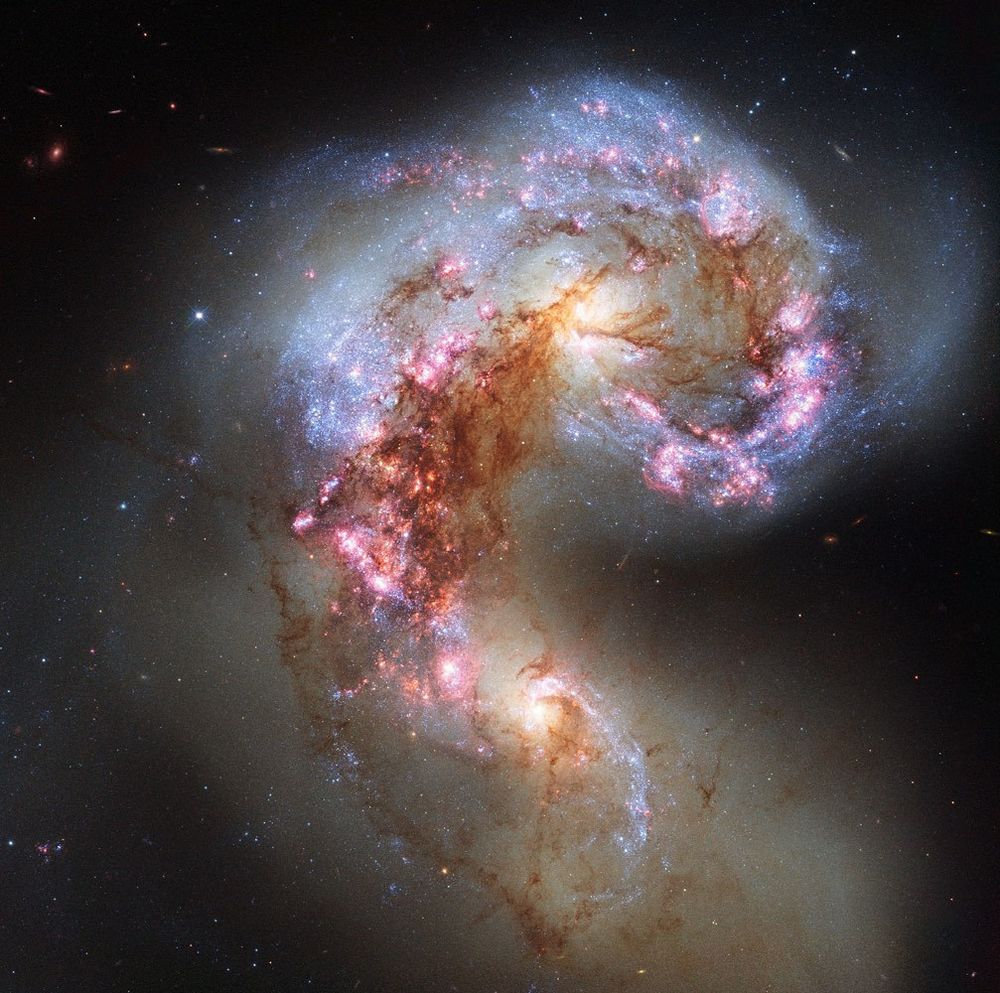
Spiral galaxies NGC 4038 and NGC 4039 –– the Antennae Galaxies. White, blue, and red swirls of stars from two disrupted spiral galaxies captured mid-collision, with messy lanes of dark gas and dust stretching between their bright yellow cores.

The globular cluster NGC 1866 in the Large Magellanic Cloud. A jewel box of tightly clustered white, blue, and red stars.
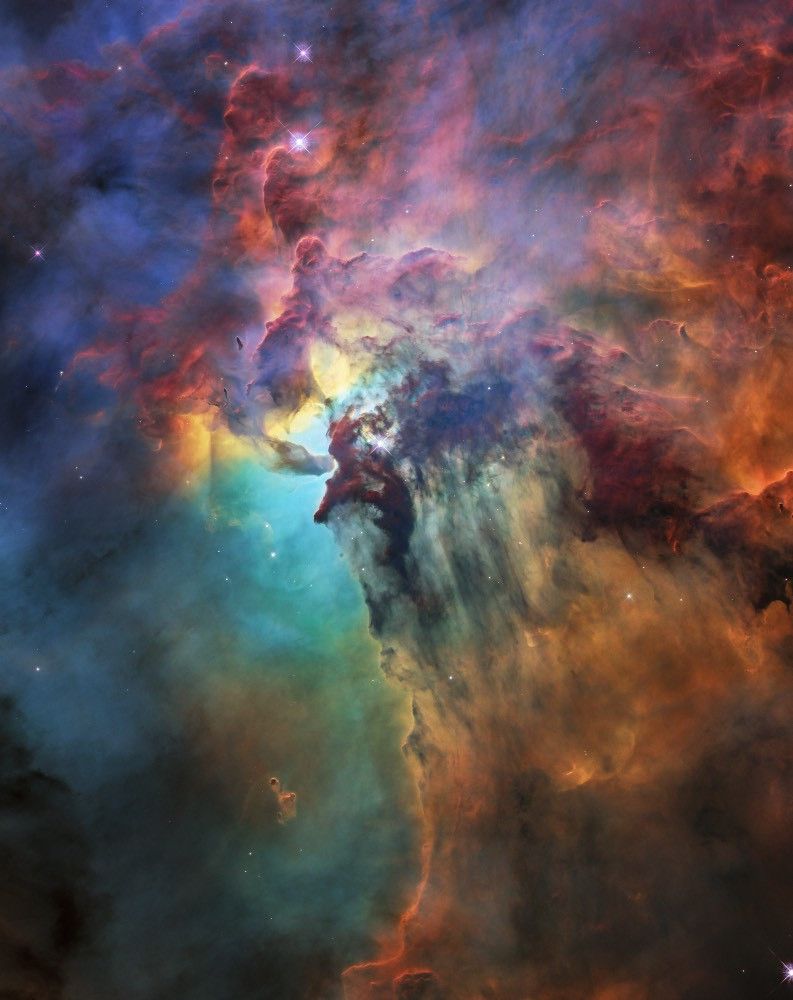
False color image of the Lagoon Nebula captured by Hubble for its 28th anniversary in 2018. Red, purple, blue, green, yellow, and orange clouds surround a region of active star formation, with our view obscured by dark molecular clouds.
Happy birthday to the Hubble Space Telescope, launched from the Kennedy Space Center #OTD in 1990. Here's to a remarkable 35 years of imaging the Cosmos. 🧪 🔭 ⚛️
Leave your favorite Hubble images in the replies!
24.04.2025 13:58 — 👍 7980 🔁 1522 💬 126 📌 78

a white palm cups a large glass pendant. The center is a series of pink blue and white circles that resemble bullseyes. Around the edges attached with silver wire are iridescent purple pink and blue wings.
I have made the most gloriously ridiculous pendant with @nora.zone glass blob. Behold the biblically accurate trans angel pendant
21.04.2025 23:48 — 👍 158 🔁 38 💬 6 📌 2

A 5 strand rosary style rainbow collar neck.
Wrecked my hands for my craft but she real pretty.
25.04.2025 05:25 — 👍 521 🔁 31 💬 28 📌 3

Book cover of Virginia Postrel's book, The fabric of Civilization, How textiles made the world
Of course! It's The Fabric of Civilization: How textiles
made the world by Virginia Postrel.
Enjoy!
25.04.2025 02:30 — 👍 4 🔁 2 💬 2 📌 0
Oh no! I visited there in 1999 with the NASA Academy.
25.04.2025 06:02 — 👍 3 🔁 0 💬 0 📌 0

Artist’s concept of Dragonfly soaring over the dunes of Saturn’s moon Titan.
NASA/Johns Hopkins APL/Steve Gribben
NASA’s Dragonfly Passes Critical Design Review
The mission to Saturn’s icy moon Titan will investigate prebiotic chemical processes and complex organic compounds that, on Earth, are the building blocks of life.
science.nasa.gov/blogs/dragon... 🧪🔭 #Dragonfly
25.04.2025 05:43 — 👍 45 🔁 11 💬 1 📌 2

Due to maintenance, Research.gov (including access to NSF-PAR, GRFP, PES, and ETAP) will be unavailable from Fri., 4/25 at 10:00 PM ET to Sat., 4/26 at 1:00 PM ET. NSF apologizes for any inconvenience.
🚨 Practical URGENT tip for NSF grantees:
Out of an abundance of caution, I would right now go into Research.gov and…
1. Download your NSF award letters.
2. Print PDF your annual reports.
3. Screenshot the status table for annual reports.
NSF is planning maintenance tomorrow to Research.gov
24.04.2025 21:32 — 👍 662 🔁 511 💬 8 📌 25

The image shows a starfield with an oval shaped red and light-blue tinged nebula in the center Please see the explanation for more detailed information.
🔭 Thor's Helmet
Image Credit & Copyright: Brian Hopkins (East Coast Astronomer)
apod.nasa.gov/apod/ap25031...
17.03.2025 08:00 — 👍 252 🔁 43 💬 5 📌 3

NASA’s James Webb Space Telescope has provided the clearest look in the infrared yet at the iconic multi-planet system HR 8799. The closest planet to the star, HR 8799 e, orbits 1.5 billion miles from its star, which in our solar system would be located between the orbit of Saturn and Neptune. The furthest, HR 8799 b, orbits around 6.3 billion miles from the star, more than twice Neptune’s orbital distance. Colors are applied to filters from Webb’s NIRCam (Near-Infrared Camera), revealing their intrinsic differences. A star symbol marks the location of the host star HR 8799, whose light has been blocked by the coronagraph. In this image, the color blue is assigned to 4.1 micron light, green to 4.3 micron light, and red to the 4.6 micron light.

Webb’s NIRCam (Near-Infrared Camera) captured this image of 51 Eridani b (also referred to as 51 Eri b), a cool, young exoplanet that orbits 890 million miles from its star, similar to Saturn’s orbit in our solar system. The 51 Eridani system is 97 light-years from Earth. This image includes filters representing 4.1-micron light as red. The background red in this image is not light from other planets, but a result of light subtraction during image processing.
It's been an exciting couple weeks for the exploration of planets around other stars.
First up: *Direct* images of planets orbiting two young, nearby stars. HR 8799 (left) has four super-Jupiters. 51 Eridani (right) has a planet 4 times the mass of Jupiter. 🧪🔭
webbtelescope.org/contents/new...
20.03.2025 19:58 — 👍 65 🔁 18 💬 4 📌 2
Our pun made it into New Scientist!
20.03.2025 11:16 — 👍 31 🔁 9 💬 3 📌 0
I just checked in at the Atlanta airport and the kiosk wanted me to show a "passport or permanent residence card."
The airline rep who was helping me said "I don't know why it's doing this it's been doing it all morning."
20.03.2025 09:02 — 👍 9913 🔁 2955 💬 561 📌 430

Recorded from 2024 March 10, to 2025 March 1, this composited series of images reveals a pattern in the seasonal drift of the Sun's daily motion through planet Earth's sky. Known to some as an analemma, the figure-eight curve was captured in exposures taken on the indicated dates only at 18:38 UTC from the exact same location south of Stephenville, Texas. The Sun's position on the 2024 solstice dates of June 20 and December 21 would be at the top and bottom of the curve and correspond to the astronomical beginning of summer and winter in the north. Points that lie along the curve half-way between the solstices would mark the equinoxes. The 2024 equinox on September 22, and in 2025 the equinox on March 20 (today) are the start of northern fall and spring. And since one of the exposures was made on 2024 April 8 from the Stephenville location at 18:38:40 UTC, this analemma project also reveals the solar corona in planet Earth's sky during a total solar eclipse.
🔭 The Solar Eclipse Analemma Project
Image Credit & Copyright: Hunter Wells
apod.nasa.gov/apod/ap25032...
20.03.2025 08:00 — 👍 165 🔁 41 💬 3 📌 2
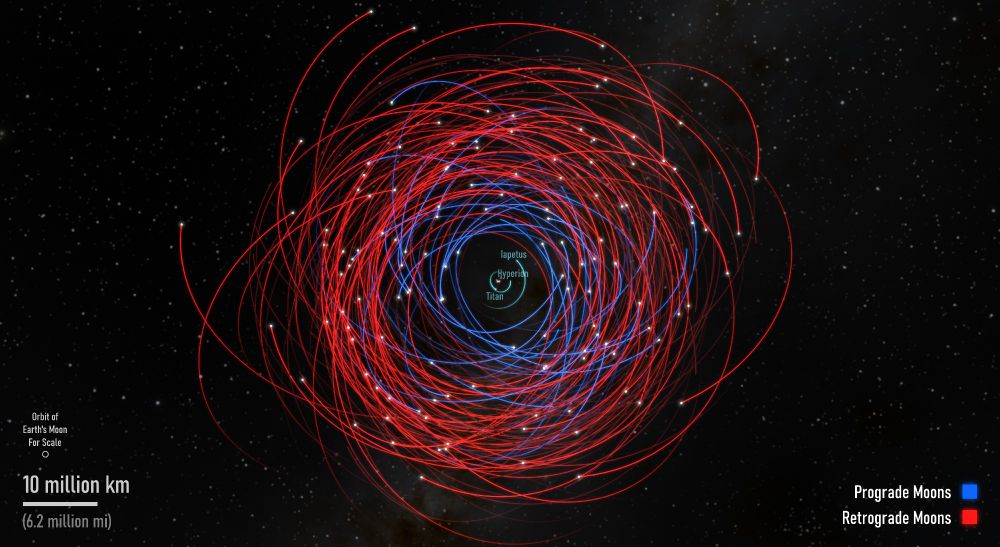
Saturn's outer moon system viewed from the north pole of Saturn. Moons orbiting in clockwise (retrograde) orbits have red-colored orbits while moons orbiting counterclockwise (prograde; in the direction of Saturn's spin) are colored blue. With so many irregular moons occupying the same region and intersecting each other, the irregular moon system looks like a donut-shaped vortex surrounding Saturn.
Each of the 128 new moons is highlighted in the diagram with a white point representing their location, and a brighter-colored orbit. Previously-known moons of Saturn are included in the diagram, but are colored darker.
The regular moons of Saturn are colored turquoise and the outermost regular moons (Titan, Hyperion, and Iapetus) labeled with their name.
At the lower left corner are scale indicators to help visualize the scale of Saturn's irregular moon system. A small gray circle at the left left corner is shown to represent the diameter of the Earth-Moon orbital distance. A linear scale bar is labeled "10 million km" (6.2 million mi) to give a standard distance.
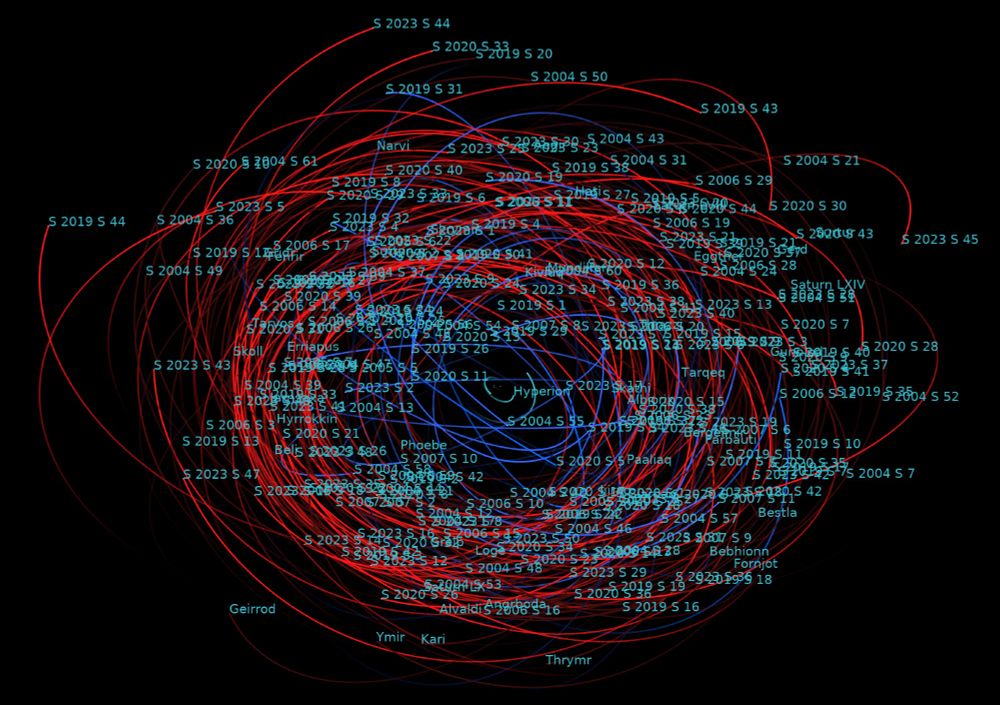
View of Saturn's irregular moon system, tilted at an angle to show the toroidal belt-like shape of the system. Each moon is labeled with their names in turquioise. Red orbits = retrograde direction, and blue orbits = prograde direction. Turquoise curves closer to the center are orbits of Saturn's regular moons.
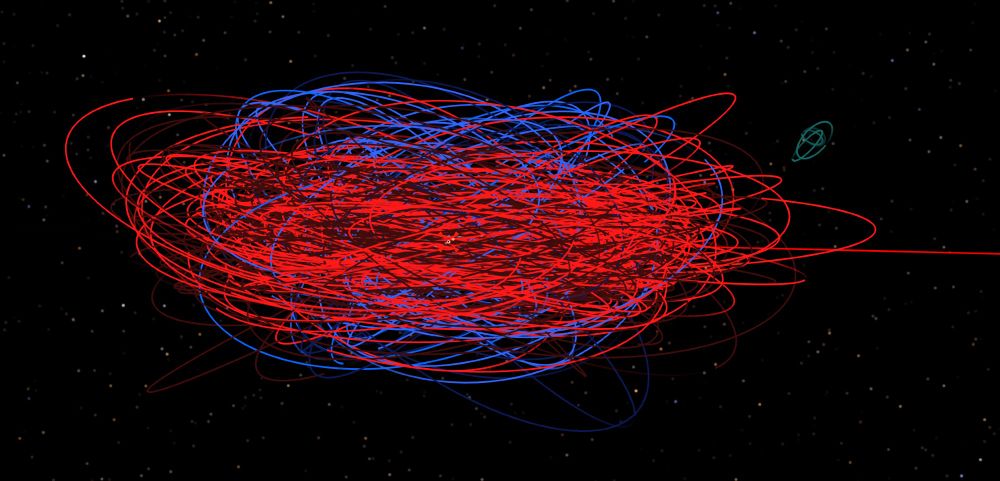
Side view of Saturn's irregular moon system, tilted at an angle to show the toroidal belt-like shape of the system. Red orbits = retrograde direction, and blue orbits = prograde direction. Turquoise curves closer to the center are orbits of Saturn's regular moons.
The irregular moons of Neptune (dark green) are also visible in the background to the right of Saturn. The horizontal red line protruding right of Saturn is the orbit path of Saturn.
I spent almost 2 hours painstakingly copying the orbits of all 128 Saturnian moons from the announcement MPEC and reformatting them for visualization...
Behold, here are the orbits of ALL 128 MOONS OF SATURN. This isn't just a moon system—it's a literal asteroid belt around Saturn! 🧪🔭☄️
12.03.2025 00:04 — 👍 2257 🔁 432 💬 92 📌 50

Lights, camera, action!
The world's largest digital camera has been installed at NSF–DOE Rubin Observatory! 🤩
The LSST Camera was the final major component of the observatory. With it in place, Rubin officially enters its final phase of testing!🔭
🔗: rubinobservatory.org/news/lsst-camera-installed
12.03.2025 15:00 — 👍 223 🔁 71 💬 5 📌 23
I was sitting on the couch with my cat, and I started singing to myself. This cat put her WHOLE paw in my mouth 😂. She really said “I’ve heard enough. We’ll call you.”
16.03.2025 01:09 — 👍 36 🔁 1 💬 1 📌 0
AAAAAAAAAAAAAAAAAAHHHHHHHHHH
16.03.2025 01:10 — 👍 36 🔁 4 💬 0 📌 0

Zoomed in photo of eclipse socks featuing the phrases of a solar eclipse

Gold solar eclipse pendant necklace depicting totality with a diamond set to illustrate the diamond ring effect
Speaking of #eclipses... Please check out my eclipse collection with socks and jewelry featuring this 'diamond ring' effect 🔭🧪
sciencesocks.co/collections/...
15.03.2025 16:34 — 👍 71 🔁 18 💬 0 📌 1

Screencap of wikipedia page with map showing a red bullseye shape on Yakutat Bay AK, with text reading "Eyewitness Accounts: The most dramatic accounts came from a group of prospectors whose camp was close to a glacial stream about a mile SE of the ice cliff of Hubbard Glacier. After the initial shock on the morning of September 10, they rigged up a seismograph using dangling knives, and counted 52 shocks before the most powerful shock occurred at noon. This was strong enough that the men could not stand, and some of them avoided being thrown about by holding on to the tent pole."
Ended up back on the Wikipedia page for the 1899 Yakutat Bay Earthquakes and now once again can't stop thinking about the knivesmograph.
15.03.2025 22:41 — 👍 119 🔁 9 💬 3 📌 4
🐡
08.03.2025 07:15 — 👍 2 🔁 0 💬 1 📌 0

A clouded leopard lays on a branch
A lil kitty cat 🦊
08.03.2025 06:22 — 👍 37 🔁 2 💬 1 📌 0

The cover for Riley Black’s book When the Earth Was Green, showing dinosaurs, prehistoric mammals, and insects among ancient plants
“Essential”
“Brilliant”
“Vivid”
“Another triumph from Black”
When the Earth Was Green: Plants, Animals, and Evolution’s Greatest Romance, blooming on bookshelves February 25th. 🌱
us.macmillan.com/books/978125...
17.02.2025 14:56 — 👍 552 🔁 145 💬 28 📌 43
I started listening to this and it feels like listening to your friend gushing about their latest hyperfixation with a new character and trying to convince you to also love them. And it's working. It's seriously written like a love letter.
26.02.2025 05:31 — 👍 216 🔁 29 💬 7 📌 0
AO 2025 for Ryugu and Bennu
If anyone is thinking of applying for a grain from asteroids Ryugu or Bennu from JAXA🛰️ for WILD BABY SPACE ROCK SCIENCE 🪨🧪, then the deadline to register intent (not the full proposal) is TOMORROW (02/26 23:59 UTC)! The website has links to the sample databases to ogle grains from both asteroids 👀
26.02.2025 05:35 — 👍 13 🔁 2 💬 3 📌 1
📌
24.02.2025 08:06 — 👍 0 🔁 0 💬 0 📌 0

See other image alt-text for description.

Figure 9. The Surface of Last Screaming. Consider an infinite field full of people screaming. The circles are their heads. You are screaming too. (Your head is the black dot.) Now suppose everyone stops screaming at the same time. What will you hear? Sound travels at 330 m/s. One second after everyone stops screaming you will be able to hear the screams from a `surface of last screaming' 330 meters away from you in all directions. After 3 seconds the faint screaming will be coming from 1 km away...etc. No matter how long you wait, faint screaming will always be coming from the surface of last screaming - a surface that is receding from you at the speed of sound (`vsound'). The same can be said of any observer - each is the center of a surface of last screaming. In particular, observers on your surface of last screaming are currently hearing you scream since you are on their surface of last screaming. The screams from the people closer to you than the surface of last screaming have passed you by - you hear nothing from them (gray heads). When we observe the CMB in every direction we are seeing photons from the surface of last scattering. We are seeing back to a time soon after the big bang when the entire universe was opaque (screaming).
In these trying times, when we all feel like screaming, I present to you the best explanation of the Cosmic Microwave Background #CMB I've ever come across: "The Surface of Last Screaming" #Science #Physics #Cosmology #Astronomy 🧪⚛️🔭 Source: ned.ipac.caltech.edu/level5/March...
20.02.2025 22:29 — 👍 96 🔁 34 💬 5 📌 1
Hugo Award-winning author, narrator, and professional puppeteer. Also has a talking cat. My latest title, Apprehension, is available wherever books are sold.
star guy, working for the astronomy community
We're the UK-based scientists working on ESA’s Euclid space telescope, on a mission to map the dark Universe! 🔭 🌀
🏠 eucliduk.net
The European Southern Observatory designs, builds & operates world-class observatories on the ground for the benefit of society. More info on eso.org
#50YearsOfESA: we're the European Space Agency, keeping you posted on European space activities.
Please see our Privacy Notice: https://esa.int/connectwithus
Super Duper Villain. Used to love #curling. Best friend of CHESTR. I use my evil powers for good.
And I'm #trans. Deal with it.
made of love and song lyrics, a token of a broken time. autonomy and solidarity forever. DFTBA
by @nora.zone, huge thanks to @jewel.andraia.xyz, @bluebotsdonequick.com. it/its
Trying to make life work by the light of a dumpster fire.
If you see someone drowning, you must try to save them. Even if you cannot swim.
digital artist! ☕
https://linktr.ee/apofiss
Artist slow as a glacier but getting better !
Ex programming/Math drone, occasionally grumpy.
Insects, gardening, science, cooking and whisky fan
No crypto 🤡 No nft and absolutely No AI, I am dead serious, gtfo!
All the socials👉 https://linktr.ee/Somklesen
Your U.S. Consumer Product Safety Commission. Product safety info, data, and recalls. Standing for safety since 1972. Official account of the USCPSC. HQ: Bethesda, MD.
Subscribe for recall emails on CPSC.gov.
Report unsafe products on SaferProducts.gov
Bibliothusiast 📚 , Artist 🎨, Writer ✒️, Yorkie Mom 🐶
NO DM'S!
Pittsburgh based cosplayer.
Cosplay, puns, and pun cosplays.



























